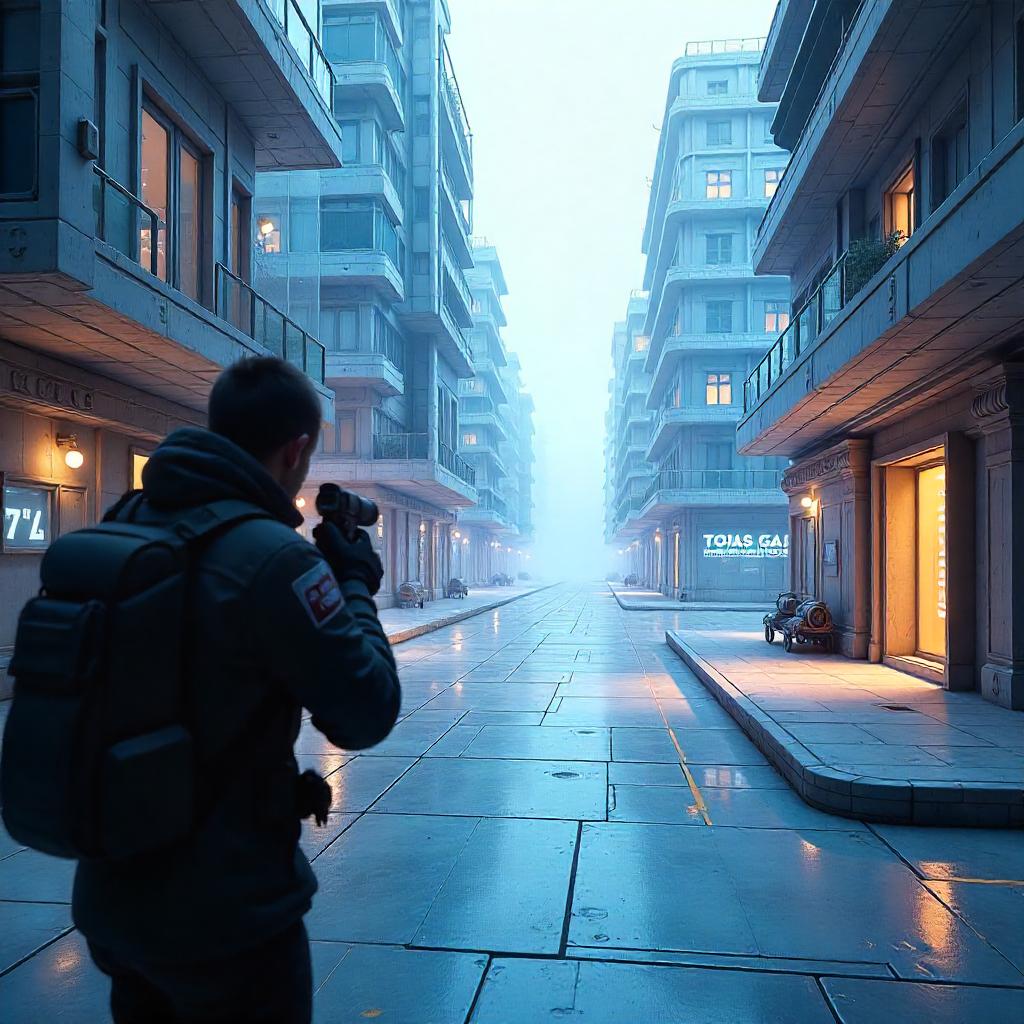In the rapidly evolving landscape of NFT gaming, the success of projects like BAD Renderings hinges not only on technological innovation but also on the strength and engagement of their communities. The integration of architectural NFTs into a first-person shooter (FPS) environment presents a unique opportunity to blend digital ownership with immersive gameplay. However, the long-term value of such projects is intricately tied to the communities they cultivate and the sustained utility they provide.
Building a Thriving Community
A robust community is the cornerstone of any successful NFT project. For BAD Renderings, fostering an active and engaged player base is crucial. This involves creating platforms for players to connect, share experiences, and provide feedback. Social media channels, dedicated forums, and in-game events can serve as vital touchpoints for community interaction.
Moreover, transparency and open communication from the development team can build trust and loyalty among players. Regular updates, responsiveness to community concerns, and active participation in discussions can strengthen the bond between the developers and the player base.
Sustaining Long-Term Value
While the initial appeal of owning a unique architectural NFT is significant, the long-term value of such assets depends on their continued utility within the game. For BAD Renderings, this means ensuring that architectural NFTs are not static collectibles but dynamic elements that evolve with the game’s development.
Implementing features that allow players to modify, upgrade, or interact with their NFTs in meaningful ways can enhance their value over time. Additionally, integrating these assets into the broader game economy, such as through rental systems or in-game events, can provide ongoing incentives for players to engage with their NFTs.
Addressing Community Concerns
The gaming community has expressed skepticism toward NFT integration, often citing concerns over environmental impact, speculative markets, and the potential for pay-to-win dynamics. Addressing these concerns transparently is essential for maintaining community trust.
For BAD Renderings, this involves adopting environmentally friendly blockchain solutions, ensuring that NFT ownership does not confer unfair advantages, and providing clear communication about the role of NFTs within the game. By aligning the project’s goals with the values of the gaming community, BAD Renderings can mitigate skepticism and foster a positive reception.
Real-World Examples
Looking at other NFT projects can provide insights into building and sustaining community engagement. For instance, projects like Aavegotchi have successfully integrated NFTs into their gameplay by allowing players to interact with and upgrade their assets, thereby maintaining long-term interest and value.
Similarly, Axie Infinity has created a thriving economy around its NFTs by enabling players to earn rewards through gameplay and participate in governance decisions. These examples highlight the importance of continuous development and community involvement in sustaining the long-term value of NFT projects.
In conclusion, the success of BAD Renderings will depend on its ability to build a vibrant community and provide sustained utility for its architectural NFTs. By focusing on community engagement, transparent communication, and meaningful integration of NFTs into gameplay, BAD Renderings can establish itself as a leader in the evolving NFT gaming landscape.
Performance & Optimization Challenges
In the realm of first-person shooters (FPS), performance is paramount. A single frame drop can mean the difference between victory and defeat. For BAD Renderings, the integration of architectural NFTs into an FPS environment presents unique challenges that extend beyond traditional game optimization.
Architectural Complexity and Rendering Demands
Each of the 27,225 NFTs in BAD Renderings represents a unique architectural design, complete with intricate details and customizable features. While this level of detail enhances the immersive experience, it also places significant demands on the game’s rendering engine. Complex models with high polygon counts can strain graphics processing units (GPUs), leading to potential frame rate drops and stuttering, especially on lower-end hardware.
Moreover, the game’s dynamic environments, which include destructible elements and real-time lighting effects, further complicate rendering processes. These features require continuous recalculation of lighting and shadow maps, which can be resource-intensive and impact overall performance.
Optimization Strategies and Their Limitations
To mitigate performance issues, developers often employ various optimization techniques, such as:
Level of Detail (LOD) Scaling: Reducing the complexity of distant objects to lessen the rendering load. Occlusion Culling: Ensuring that only visible objects are rendered, preventing unnecessary computations. Efficient Asset Management: Implementing compressed textures and optimized meshes to reduce memory usage.
While these strategies can yield improvements, they may not fully address the performance challenges posed by the unique architecture of BAD Renderings. The sheer volume of unique assets and the need for real-time interactions introduce complexities that standard optimization methods may not resolve.
Real-World Performance Observations
Community feedback highlights the tangible impact of these performance challenges. Players have reported experiencing frame rate drops and stuttering, even on high-end systems. For instance, a user with an RTX 4070 GPU and a Ryzen 5600X CPU noted that despite achieving up to 90 FPS, the gameplay felt akin to 30 FPS due to stuttering and inconsistent frame times.
Such discrepancies underscore the importance of continuous optimization and the need for developers to consider the diverse hardware configurations of their player base.
The Importance of Ongoing Optimization
As BAD Renderings continues to evolve, ongoing optimization efforts are crucial. Developers must prioritize performance enhancements to ensure a smooth and enjoyable experience for all players. This includes:
Regularly updating the game engine to leverage advancements in graphics technology. Collaborating with the community to identify and address performance bottlenecks. Providing players with tools and settings to customize their experience based on their hardware capabilities.
By addressing these performance and optimization challenges, BAD Renderings can deliver a seamless and engaging FPS experience that fully realizes the potential of its architectural NFT integration.
NFT & Blockchain Integrity
In the evolving landscape of NFT gaming, the intersection of blockchain technology and gameplay introduces a complex array of considerations. For BAD Renderings, the integration of architectural NFTs into a first-person shooter (FPS) environment necessitates a robust and transparent blockchain framework to ensure both the functionality and trustworthiness of the game.
Smart Contract Transparency and Security
At the core of any NFT-based game lies the smart contract—the self-executing code that governs the creation, transfer, and interaction of NFTs within the game. For BAD Renderings, the smart contracts underpinning the architectural NFTs must be meticulously designed and thoroughly audited to prevent vulnerabilities that could be exploited by malicious actors.
Transparency in the smart contract code is paramount. Players and investors alike need assurance that the contracts are free from hidden clauses or backdoors that could compromise the integrity of the game. Independent audits by reputable firms can provide this assurance, fostering trust within the community.
Metadata Integrity and Decentralization
The permanence and authenticity of NFTs are largely determined by their metadata—the information that describes and defines the asset. For BAD Renderings, ensuring that the metadata associated with each architectural NFT is immutable and decentralized is crucial.
Utilizing decentralized storage solutions, such as the InterPlanetary File System (IPFS), can safeguard against data loss or tampering. By storing metadata off-chain in a decentralized manner, the game ensures that each NFT retains its uniqueness and authenticity, even if the original hosting platform experiences issues.
Royalty Structures and Revenue Distribution
One of the appealing aspects of NFT integration in gaming is the potential for creators to earn royalties from secondary sales. For BAD Renderings, establishing a clear and fair royalty structure is essential to incentivize both creators and players.
The royalty percentages should be transparently defined and consistently applied across all platforms where the NFTs are traded. Additionally, the distribution of these royalties must be automated and verifiable through the blockchain, ensuring that creators receive their due compensation without delays or disputes.
Legal Considerations and Compliance
The incorporation of NFTs and blockchain technology into gaming introduces a host of legal considerations. For BAD Renderings, navigating the regulatory landscape is essential to avoid potential legal pitfalls.
This includes ensuring compliance with intellectual property laws, as the unique architectural designs of the NFTs may be subject to copyright protection. Additionally, adherence to financial regulations concerning digital assets and transactions is necessary to operate within the bounds of the law.
Community Trust and Transparency
Ultimately, the success of BAD Renderings hinges on the trust and confidence of its community. Transparent communication regarding the game’s blockchain infrastructure, smart contract audits, metadata storage solutions, royalty structures, and legal compliance efforts can foster a strong sense of security among players and investors.
By prioritizing blockchain integrity and maintaining an open dialogue with the community, BAD Renderings can establish itself as a trustworthy and innovative player in the NFT gaming space.
Community Response & Market Sentiment
The launch of BAD Renderings has sparked a wave of discussion within the NFT and gaming communities. As with any innovative project, reactions have been mixed, reflecting both excitement and skepticism.
Enthusiasm for Innovation
Many community members have expressed enthusiasm about the unique concept of integrating architectural NFTs into a first-person shooter (FPS) environment. The idea of owning a personalized in-game space that serves as both a strategic asset and a customizable environment resonates with players seeking deeper immersion and ownership in their gaming experiences.
This innovative approach has garnered attention from NFT collectors and gaming enthusiasts alike, eager to explore the potential of this new model. The promise of a seamless blend between digital ownership and interactive gameplay has been highlighted as a significant step forward in the evolution of NFT gaming.
Concerns Over Performance and Accessibility
Despite the innovative concept, concerns have been raised regarding the game’s performance and accessibility. Players have reported experiencing frame rate drops and stuttering, even on high-end systems. For instance, a user with an RTX 4070 GPU and a Ryzen 5600X CPU noted that despite achieving up to 90 FPS, the gameplay felt akin to 30 FPS due to stuttering and inconsistent frame times.
These performance issues have led to discussions about the game’s optimization and the technical challenges of integrating detailed architectural models into a fast-paced FPS environment. Players have expressed the need for ongoing updates and improvements to ensure a smooth and enjoyable experience.
Market Sentiment and Investment Outlook
From an investment perspective, the market sentiment surrounding BAD Renderings is cautiously optimistic. The project’s innovative approach positions it as a potential leader in the evolving NFT gaming space. However, the concerns over performance and the need for further development have tempered enthusiasm among potential investors.
The project’s success will likely depend on its ability to address these technical challenges and deliver a seamless gaming experience. If the developers can optimize performance and maintain the innovative aspects of the game, BAD Renderings could set a new standard for NFT-based gaming experiences.
In conclusion, while BAD Renderings has generated significant interest and excitement, it faces challenges that need to be addressed to realize its full potential. The community’s response underscores the importance of balancing innovation with technical execution to create a compelling and sustainable gaming experience.
Pros, Cons & Risk Assessment
The integration of architectural NFTs into a first-person shooter (FPS) environment, as exemplified by BAD Renderings, introduces a novel approach to gaming. However, this innovation comes with its own set of advantages, challenges, and risks that both players and developers must consider.
Pros
True Digital Ownership
NFTs offer players genuine ownership of in-game assets, allowing them to buy, sell, or trade architectural designs as they would with physical collectibles. This decentralization ensures that assets are not confined to a single platform or developer, providing players with more control over their digital possessions.
Enhanced Customization and Immersion
The ability to own unique architectural NFTs enables players to personalize their in-game environments, enhancing immersion. Customizable homes and structures can serve as strategic assets, influencing gameplay and providing a deeper connection to the game world.
Potential for Passive Income
Through mechanisms like royalties from secondary sales, players can potentially earn passive income from their NFTs. This economic model incentivizes engagement and investment in the game, creating a dynamic economy within the gaming ecosystem.
Community Engagement and Governance
NFTs can facilitate community-driven development and governance. Players who own architectural NFTs may have a say in the evolution of the game, contributing to a more inclusive and player-centric development process.
Cons
High Entry Costs
Acquiring architectural NFTs can be expensive, especially for high-quality or rare designs. This financial barrier may exclude potential players and create a pay-to-win environment, where success is more dependent on investment than skill.
Market Volatility
The value of NFTs can fluctuate significantly due to changes in demand, market trends, and cryptocurrency valuations. Players and investors may face financial risks if the value of their assets decreases unexpectedly.
Technical Challenges
Integrating detailed architectural models into an FPS environment can strain game performance. Issues such as frame rate drops and stuttering may arise, affecting gameplay quality and user experience.
Environmental Impact
The energy consumption associated with blockchain transactions, particularly on networks like Ethereum, has raised environmental concerns. The carbon footprint of minting and trading NFTs may deter environmentally conscious players.
Risk Assessment
Regulatory Uncertainty
The legal landscape surrounding NFTs and blockchain gaming is still evolving. Unclear regulations may pose risks related to taxation, intellectual property rights, and consumer protection.
Security Vulnerabilities
Despite the security features of blockchain technology, NFTs are not immune to hacks and fraud. Players must be vigilant against phishing attacks, scams, and other malicious activities that could compromise their assets.
Economic Sustainability
The long-term viability of NFT-based gaming economies is uncertain. Over-reliance on speculative investments and secondary sales may lead to economic instability within the game, affecting both developers and players.
Market Saturation
An oversupply of NFTs can dilute their value, leading to market saturation. Developers must carefully manage the issuance of new NFTs to maintain scarcity and demand.
In conclusion, while BAD Renderings presents an innovative fusion of architecture and gaming, it is essential for players and developers to weigh the potential benefits against the inherent risks. By staying informed and exercising caution, stakeholders can navigate the complexities of NFT gaming and contribute to its sustainable growth.
Final Verdict & Next Steps
BAD Renderings stands at the crossroads of innovation and skepticism in the realm of NFT gaming. Its ambitious fusion of architectural NFTs with first-person shooter (FPS) mechanics offers a novel approach to digital ownership and gameplay. However, as with any pioneering endeavor, it faces a spectrum of challenges that could influence its trajectory in the gaming landscape.
Final Verdict
BAD Renderings introduces a compelling concept that could redefine player engagement and asset ownership in gaming. The integration of architectural NFTs allows for a level of personalization and investment previously unseen in FPS titles. Yet, the project’s success hinges on its ability to address significant concerns, particularly regarding performance optimization and community reception.
The mixed reactions from the gaming community underscore the delicate balance required between innovation and execution. While some players express excitement over the potential of owning unique in-game assets, others remain wary of the technical and economic implications of NFT integration. (reddit.com)
Next Steps
For BAD Renderings to realize its full potential, several strategic actions are essential:
Performance Optimization: Prioritize addressing technical issues to ensure a seamless gaming experience. This includes refining rendering processes and optimizing game performance across various hardware configurations.
Community Engagement: Foster open communication channels with the player base. Actively seek and incorporate player feedback to build trust and enhance the game’s development.
Educational Initiatives: Provide resources to educate players about the benefits and mechanics of NFTs in gaming. Transparency regarding the role of NFTs can alleviate concerns and promote informed participation.
Sustainable Economic Models: Develop and implement economic structures that ensure long-term viability. This involves creating balanced tokenomics and exploring alternative revenue streams to reduce reliance on speculative markets.
In conclusion, while BAD Renderings presents an intriguing vision for the future of gaming, its success will depend on thoughtful execution and a commitment to addressing the multifaceted challenges it faces. By aligning technological advancements with community interests and sustainable practices, it has the potential to carve out a significant niche in the evolving NFT gaming ecosystem.





